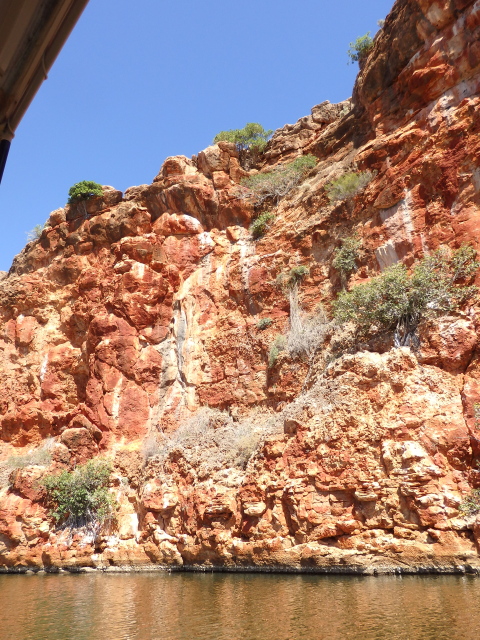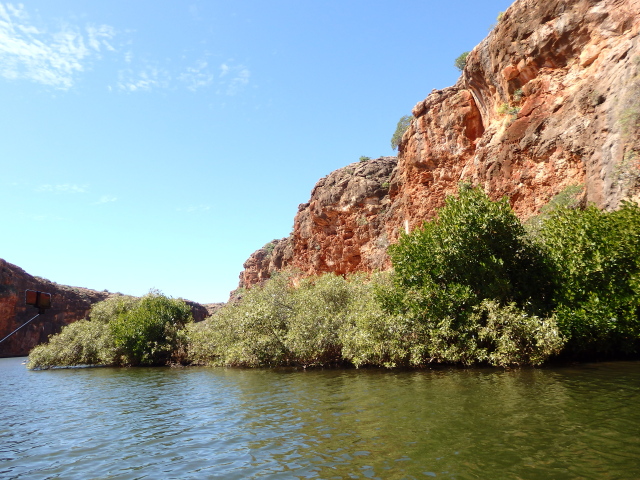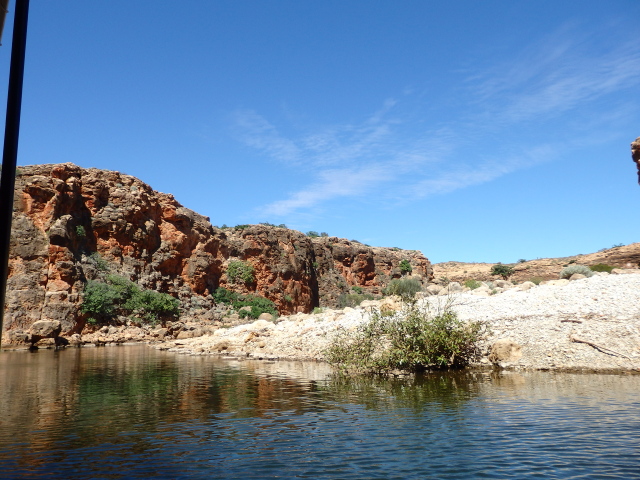After 3 nights at the Monkey Mia resort it was off north to Carnarvon on day 8, already one week on the road. Even though we are in a chilled mood, one week seems to have slipped past quite quickly. Now we are past the 26th parallel and in a much dryer climate the vegetation has changed quite dramatically. Although there is some rain at this time of the year it is very windy and hot in summer so there is no agricultural cropping to see just the occasional cow, sheep or goat munching on sparse bush. But the wonder of West Australia’s wildflowers were on show with everlastings out beside the road. https://www.westaustralianexplorer.com/the-incredible-wildflowers-of-western-australia/
Carnarvon was our home 30 years ago and although we had returned once, it was a couple of decades ago. We stayed in the motel we had stayed in on our first night back in 1990 and it had not changed at all; same rooms, restaurant, swimming pool and friendly staff. In all fairness to the town there had been a few positive changes, to the fascine waterfront and the streetscape plus new tourist attractions. But the shopping centre where Tony spent most of his time is in very poor shape with nearly all the shops empty. There are a few outdoor cafes to choose from in the main street and a market at the Tourist Bureau on Saturday mornings with local craft, jams and food. The new Aboriginal Gwoonwardu Mia Cultural Centre was closed at the weekends, unfortunately, so we didn’t get to look around or see the Lock Hospital stories too. Going back to a place you have lived is often a bit surreal when you have done different things in the meantime and the place appears much the same as when you left.
NASA built a tracking station on Mt Brown just outside Carnarvon in 1963 and this was used for the Gemini, Apollo and Skylab projects because continual communication between space and Houston was impossible in those days. Now a space and technology museum, we spent an interesting couple of hours wandering around the various displays including one highlighting the first television direct telecast from the UK in 1966 when the BBC brought out reporters and cameramen . https://www.youtube.com/watch?v=T61qss-SJds
We headed directly north on day 10 along a fairly crowded highway to Minilya Roadhouse for a welcome coffee then off towards the coast again and Coral Bay, the start of Ningaloo Reef. We holidayed here a couple of times with very young kids when the caravan park and one shop was all the infrastructure that was here. Well it’s now like a mini city, albeit at an extraordinary period in time with the covid travel restrictions. We had a tasty lunch and a nice beach walk but didn’t hang around with the crowds for very long before heading to Exmouth.
Exmouth was built when the Yanks came to North West Cape in the 1960’s. Needing a base with Indian Ocean frontage and some remoteness, it was ideal except for the harsh summer climate and constant threat of cyclones. The US Navy left almost 30 years ago so now it is primarily a tourist town with magnificent natural attractions such as the Ningaloo Reef and Cape Range. We were booked into an Airbnb for 4 nights, so we took our time seeing the sights and relaxed with good internet, home cooking and pleasant warm days.
Exmouth is usually pretty busy at this time of year with the Grey Nomads getting away from colder weather, this year it is chokka full. So the 2 tours we did was full of Westralians; a boat trip up Yardie Creek and a glass bottom boat out on the reef. We spent one late afternoon as the sun set up next to the Vlamingh Head Lighthouse watching a large numbers of humpback whales just out beyond the reef (100 metres from shore) on their biannual migration from the Antarctic to the Kimberley.
Our first really long day of driving went very smoothly as we travelled from Exmouth up to Karratha in the Pilbara, about 6 hours. We stopped and swapped driving duties a few times and kept the podcasts and music flowing. Devonshire tea at Bullara Station at the head of Exmouth Gulf was our first stop where the coffee was equal to Perth’s best. We had to slow down a couple of times to let the big brahmin bulls that graze beside the road pass across but otherwise kept to a constant speed. It really is a vast great expanse, an ancient empty landscape with the odd flat topped geological outcrop to break it up. At waterholes we usually spotted a few caravanners resting up and, as we neared Karratha, it unexpectantly became much greener and lusher, the result we later found out of some huge tropical rain storms in May and June.
Karratha is a large modern outback town designed and built specifically to service the mining industry by Rio Tinto, formerly Hammersley Iron. The region was formerly mined for copper, tin, asbestos and gold and had extensive sheep farms but is now predominantly the open cast mine for China’s insatiable iron ore appetite. There are also huge LNG hubs operating on the Burrup peninsula and more in development. The ore is transported on kilometre long driverless trains from the mines in the Hammersley Ranges to colossal ships lined up along the coast. The sheer size of the whole exercise is mind-boggling.
We stay with a friend in the Karratha suburbs for a few nights, a lovely break from the usual accommodation and an opportunity to converse and enjoy someone else’s company. The city of Karratha has very good services albeit in a challenging climate with very hot summers and has the most cyclone-prone coast in Australia.
Touring the area is very easy with great roads. We visited the Port of Dampier, named after the English pirate who explored much of Australia in the 1600’s, landed nearby and noted the flora and fauna and the indigenous inhabitants. It is a sleepy little town that is the gateway to the Burrup peninsula across large expanses of salt pans. The port exports huge amounts of iron ore, salt, natural gas and petrochemicals.
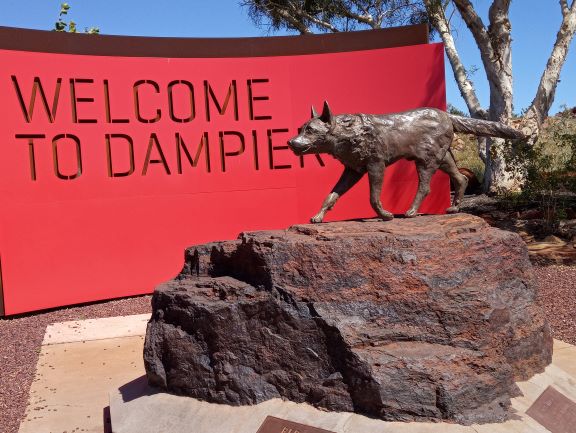
Jo showed us around an area north of Karratha around Cossack and Roebourne where European and Indigenous history is well documented. The old towns have several 19th Century historic public buildings in local stone that have been looked after and are still being used. We had the best fish and chips in the north-west in Point Samson – juicy, freshly caught and well-cooked local fish.
Roebourne has an old gaol built to house Aboriginal prisoners in the 1880’s, many of whom were blackbirded and were guilty of nothing really except being in the wrong place. It is a town with an appalling reputation after being used to house the original ore mining workers in the 1960’s (because there was nowhere else for them to live) and became a place of drunkenness and violence. In the old hotel there is the Ganalili Centre where Yindjibarndi artists display and sell their beautiful works and there are extensive interactive displays about the local environment and their Dreamtime stories.
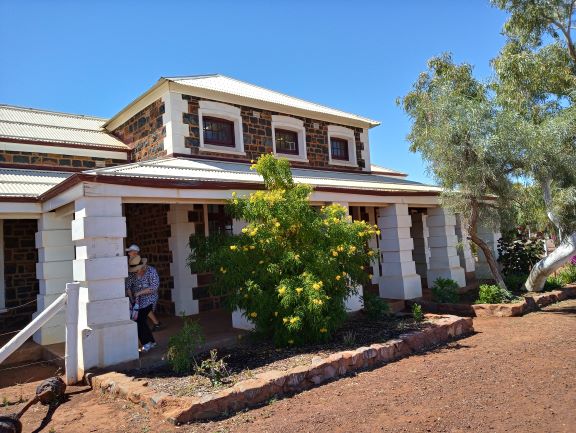
Cossack Court House 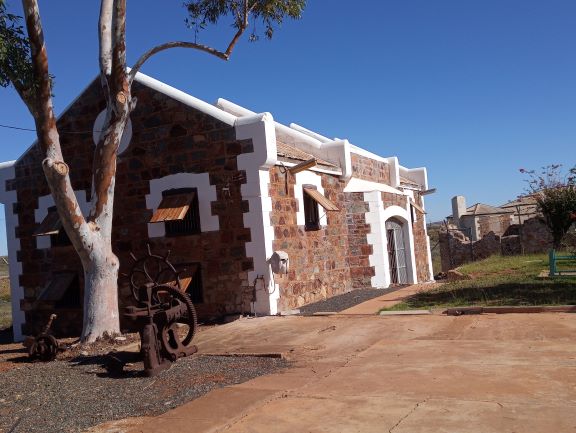
Roebourne Gaol
Then, on Monday, we hit the road for Broome – depending on which map we consulted it was about 750 kms from Karratha! We stopped at Port Hedland for a delicious breakfast near the port – another town dedicated to mining. The road to Broome is long and straight and good to drive on with most caravans and road trains going the other way. We finally reached Broome about 5pm and after an hour spent at the friendly and helpful Broome Visitor Centre yesterday we have a few days worth of activities lined up….more about that in the next instalment!

